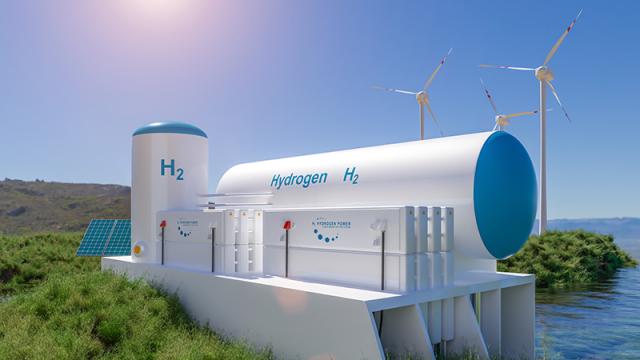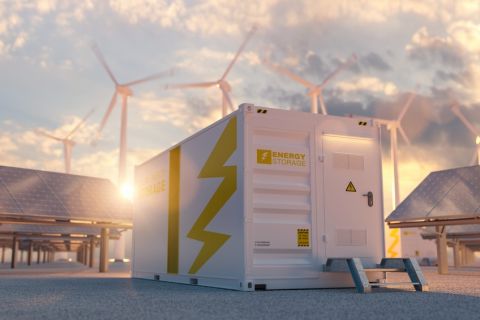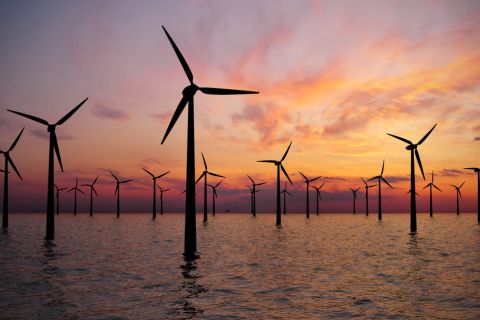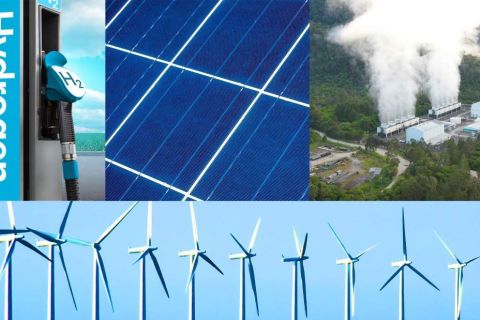
A 3-D rendering of a green hydrogen tank, in which production is powered by a wind turbine. (Source: Alexander Kirch/Shutterstock.com)
Caught up in the current hype surrounding hydrogen as clean energy’s darling, it might be easy to forget that H2’s ascension to global dominance is not a sure thing. There are a host of barriers in its way, a panel of hydrogen experts said during an April 13 webinar hosted by Reuters.
Among them are infrastructure, funding, storage, transportation, compression, life-cycle emissions, regulatory framework, investment risks and economic viability.
That said, experts still vote for hydrogen as the clean energy source most likely to succeed.
“We’ve looked at many scenarios … and we cannot envision a path where hydrogen couldn’t play an important role in getting to this net-zero world, including reducing the carbon-intensity of the products that we sell to our customers,” Paul Bogers, Royal Dutch Shell’s vice president of hydrogen, said during the webinar.
Going Somewhere?
Assuming fuel can be produced in sufficient abundance that warrants exporting it, simply moving the fuel from here to there becomes a challenge. Domestic transport can be achieved through specially designed pipelines or modified natural gas pipelines. Exporting the fuel is completely different.
“Although I love hydrogen as a molecule—it’s the most abundant element—it’s wonderful in every way, shape or form except for shipping it,” Bogers said.
There are ways to do it, but they’re not easy. One is to liquefy hydrogen, which is accomplished by cooling it to -423 F, then storing it in large insulated tanks. By comparison, the liquefaction process for LNG requires a cooling temperature of -260 F. Other drawbacks include the loss of some fuel through evaporation, the high cost and, utilizing the technology as it exists today, consumption of more than 30% of the energy content of the hydrogen.

Clockwise from top left: Owen Rolt, moderator from Reuters; Ana Quelhas, director of energy planning for EDP; Paul Bogers, Royal Dutch Shell’s vice president, hydrogen; and Sunita Satyapal, director of the U.S. Department of Energy’s Hydrogen and Fuel Cell Technologies Office. (Source: Reuters)
“That kind of eases your opportunity to ship the energy across large distances, but then also becomes more tricky to convert, crack that ammonia back into hydrogen, depending on what the use case is,” Bogers said.
There may be some hope on that front. A team of researchers at Northwestern University developed an electrochemical system to generate pure hydrogen from ammonia using renewable electricity instead of fossil-fueled thermal energy. With this system, a country without fossil fuel resources would be able to produce domestic hydrogen for fuel cells.
Making the Rules
“Scale is critical,” said Ana Quelhas, director of energy planning for EDP, a Lisbon-based energy company. The ability to produce sufficient volumes carries along with it manufacturing efficiencies derived from technological advances. That comes from investment in research and development.
“The only way we do that is through the right regulatory framework … and having the means to de-risk the decision-making process,” Quelhas said. “Investors will know we’re making decisions that will last for decades and so it’s a huge risk that investors will have to assume.”
Sunita Satyapal, director of the U.S. Department of Energy’s Hydrogen and Fuel Cell Technologies Office, understands the importance of a regulatory framework.
“What are the greenhouse gas emissions on a life-cycle basis for that hydrogen that’s being exported or imported?” she asked. “We all need to make sure we’re using the right analytical framework. What are the boundary conditions? Is the hydrogen really clean? Those types of activities have been underway on the government side and obviously have to continue.”
Satyapal is also focused on de-risking the technology to encourage the private sector to invest. Part of her mission is figuring out how to scale up production in the right strategic way.
“Ideally, if we can co-locate large-scale production, it can be a combination of blue and green and have the right off-takers so we can stimulate the market and really create that composition,” she said.
Hydrogen as a gas is colorless, of course, but the labels of gray, blue and green weigh heavily in the energy transition milieu. Gray hydrogen is produced from natural gas and accounts for about 95% of the world’s total production. Blue hydrogen is low-carbon and produced from non-renewable sources. Green hydrogen is low-carbon, but produced from renewable sources, including solar and wind.
Bogers views hydrogen production combined with carbon capture, and wind-powered electrolysis as steps to phase out gray hydrogen and displace it with blue and green hydrogen.
Quelhas has her doubts.
“We have some doubts on the future of blue hydrogen in the context of full decarbonization because it will not serve as if we don’t go up to the 100% capture of the CO2,” she said, adding that security of supply is also an important aspect. “A lot of countries don’t have the fossil fuel resources” to produce blue hydrogen but would be able to produce green hydrogen with wind or solar power.
Not a Done Deal
Immediate challenges are not terribly difficult to identify. Bogers listed some as:
- The need to ramp up R&D;
- Reduce the cost of electrolyzers;
- Increase production of fuel cells to make them affordable; and
- Same for all of the components that go into fuel cell vehicles.
“In my job I get to read a lot of beautifully crafted reports with bar charts and pie charts and cost curves that all make assumptions,” he said. “So one of the barriers I see is that those costs curves are not a law of nature. They’re not a given. They won’t just happen by design.”
The swift ramp-up in wind power surprised some because the analyses underestimated how quickly costs would come down. That’s no guarantee it will happen again with hydrogen.
“There’s so many different pieces of that puzzle that need to kind of come together,” Bogers said. “But I think what I see in all of those reports is just a kind of an assumption that that will all happen almost by default because we have that positive use case where we’ve been pleasantly surprised by how fast the cost of renewables have come down.”
There will be a significant need for infrastructure and R&D investment, he said, but also for clearly thought-out government policies.
“The regulatory framework has to be really coherent and fit together,” Bogers said, “so that people can make these long-term investment decisions to make the change happen.”
Recommended Reading
RWE Boosts US Battery Storage with Three Projects
2024-02-14 - The three projects—two in Texas and one in Arizona—will lift RWE’s total U.S. battery storage capacity to about 512 megawatts.
Energy Transition in Motion (Week of April 12, 2024)
2024-04-12 - Here is a look at some of this week’s renewable energy news, including a renewable energy milestone for the U.S.
Equinor, Ørsted/Eversource Land New York Offshore Wind Awards
2024-02-29 - RWE Renewables and National Grid’s Community Offshore Wind 2 project was waitlisted and may be considered for award and contract negotiations later, NYSERDA says.
Avangrid Begins Construction on its First California Solar Farm
2024-04-10 - Avangrid’s Camino Solar project will generate 57 megawatts of power, the equivalent of the power needs of about 14,000 U.S. homes.
Energy Transition in Motion (Week of Feb. 16, 2024)
2024-02-16 - Here is a look at some of this week’s renewable energy news, including the outlook for solar and battery storage in the U.S.






